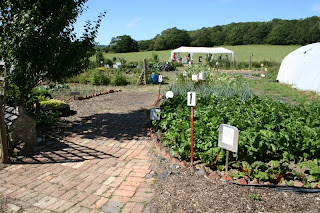Last weekend I went on a family outing to Sussex to see where my brother works at www.commonwork.org as they had an open day.
It was fascinating and inspiring, I discovered:
- nettle tea goes clear when you add lemon drops
- how to bodge a rounders bat
- when to collect woad for dyeing
- a new drink called kefir - its fizzy yoghurt and its yummy. I have been craving it since trying the free sample
- that all the sheeps wool in the UK ends in a single processing plant, I think its in Huddersfield - but do correct me - and from there it gets auctioned once a week to highest bidders.
- how to make artists charcoal
- that buddleia makes a good yellow dye even after the flowers are dead
I also got some beeswax, a diblet, milk fresh from the cow, honey, sunshine, a delicious lunch of mutton, organic beetroots, a lesson in wood turning from a delightful man called Bob, some fresh willow charcoal, and a lift there and back from mum and dad.
Super nice man who swapped charcoal with me
Super super nice Bob who let me wreck several pieces of wood on his pole lathe...
It was really great and interesting. I wish I lived in a town like that. I am saving up so I can go on a course and make a shave horse next May. Will have to get a house to keep it in as well....
It was fascinating and inspiring, I discovered:
- nettle tea goes clear when you add lemon drops
- how to bodge a rounders bat
- when to collect woad for dyeing
- a new drink called kefir - its fizzy yoghurt and its yummy. I have been craving it since trying the free sample
- that all the sheeps wool in the UK ends in a single processing plant, I think its in Huddersfield - but do correct me - and from there it gets auctioned once a week to highest bidders.
- how to make artists charcoal
- that buddleia makes a good yellow dye even after the flowers are dead
I also got some beeswax, a diblet, milk fresh from the cow, honey, sunshine, a delicious lunch of mutton, organic beetroots, a lesson in wood turning from a delightful man called Bob, some fresh willow charcoal, and a lift there and back from mum and dad.
Super nice man who swapped charcoal with me
Super super nice Bob who let me wreck several pieces of wood on his pole lathe...
It was really great and interesting. I wish I lived in a town like that. I am saving up so I can go on a course and make a shave horse next May. Will have to get a house to keep it in as well....











Comments
Post a Comment